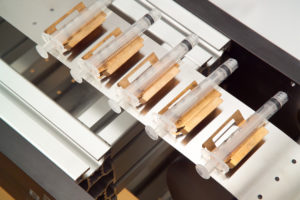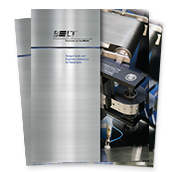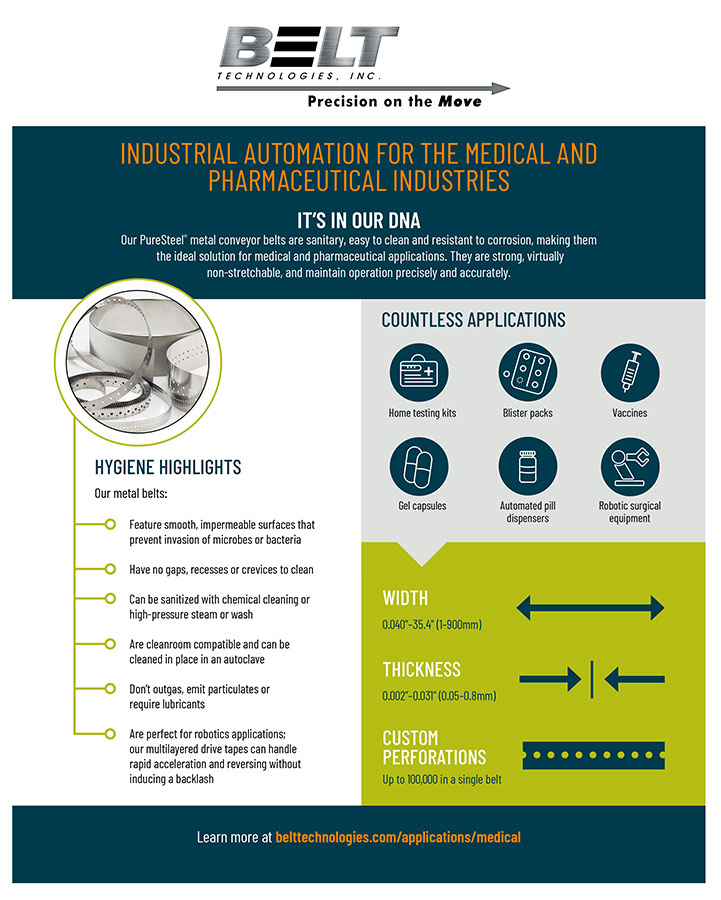The pharmaceutical market is highly competitive and requires pharmaceutical OEMs to produce equipment that guarantees quality and safety while maintaining high efficiency and low production costs. Customers demand pharmaceutical processing equipment that is fast, accurate, easy to clean, and durable. Metal belt conveyor systems are an integral tool for meeting the variety of manufacturing needs and goals for both pharmaceutical OEMs and their customers.
Reduce Contamination Risks with Stainless Steel Belts
The main advantage of a metal belt conveyor system over other materials such as rubber or plastic is cleanliness. Pharmaceutical production, much like the food industry, requires an easily sanitized environment. The strong, impermeable surface of stainless steel minimizes bacterial attachment and also resists scratches, pits, and other damages that can harbor microbial contamination. Equipment that is easily cleaned and maintained helps ensure the safety of both customers and employees. Disinfectants such as alcohols, aldehydes, peracetic acid and hydrogen peroxide are frequently used for contamination control procedures; the properties of steel allow for rigorous chemical cleaning while maintaining its integrity.
Metal Belts Withstand Challenging Environmental Conditions
A related consideration for pharmaceutical conveyor belt materials is corrosion resistance. Metal belt conveyor systems are capable of withstanding the thorough sanitization regime necessary to maintain a proper clean room. 300 series austenitic stainless steels show superior corrosion resistance while maintaining excellent strength, formability, fabricability, and ductility compared to other materials. The high chromium, nickel, and molybdenum content of these steels create a protective chromium oxide surface layer that allows them to resist nearly all forms of corrosion.
 In addition to inherent corrosion resistance, metal belts withstand high- and low-temperature operating environments that rubber, plastic, or fabric belts cannot. The temperature-resistant qualities of metal belts are advantageous in heated applications such as sterilization tunnels for depyrogenation of glass vials or hot-air drying chambers for pre-coated blood filter processing. Similarly, metal belts are well-suited to low-temperature processes, including cryogenic applications, that could cause brittleness or breakage in alternative materials. When combined with CIP sanitization procedures, metal belts can reduce contamination risks while increasing efficiency by reducing required maintenance downtime.
In addition to inherent corrosion resistance, metal belts withstand high- and low-temperature operating environments that rubber, plastic, or fabric belts cannot. The temperature-resistant qualities of metal belts are advantageous in heated applications such as sterilization tunnels for depyrogenation of glass vials or hot-air drying chambers for pre-coated blood filter processing. Similarly, metal belts are well-suited to low-temperature processes, including cryogenic applications, that could cause brittleness or breakage in alternative materials. When combined with CIP sanitization procedures, metal belts can reduce contamination risks while increasing efficiency by reducing required maintenance downtime.
Product Quality Relies On High Accuracy and Repeatability
The pharmaceutical industry relies on the accuracy and repeatability of its machinery and processes to create products that will meet the needs of pharmaceutical producers. Metal belt conveyor systems offer high-precision tolerances that other materials cannot attain. Metal belts are virtually unstretchable and will maintain accuracy throughout the lifetime of the machine. A common barrier to accuracy on belt conveyor systems is micro part slipping. Due to inertia overcoming the belt friction, a part can move out of place, lowering the accuracy of the system. Metal belts allow for the use of part fixtures to create highly precise systems. Metal belt conveyor systems are highly customizable in order to meet production needs and tight tolerances.
Selecting the correct materials is a critical step in designing a conveyor system that will optimize production rates while maintaining safety. By matching the material to the application, OEMs can avoid unnecessary downtime, increase production rates, and ensure the safety of customers and employees alike.



